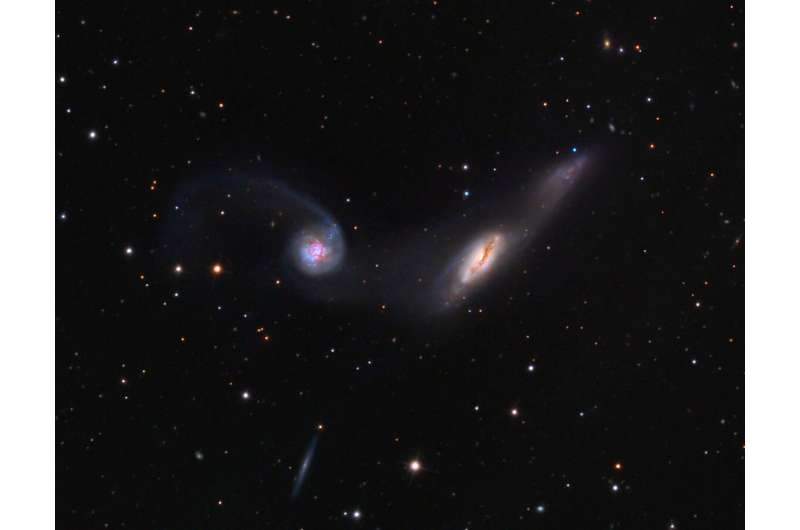January 19, 2022 report
Active galactic nucleus in NGC 2992 explored by researchers

Researchers from the U.S. Naval Observatory and elsewhere have performed simultaneous observations of an active galactic nucleus (AGN) in the galaxy NGC 2992 using the Very Long Baseline Array (VLBA) and NASA's Swift spacecraft. Results of the study, presented January 13 on arXiv.org, shed more light on the properties of this AGN and its galaxy.
AGNs are accreting, supermassive black holes (SMBHs) residing at the centers of some galaxies, emitting powerful, high-energy radiation as they accrete gas and dust. These nuclei can form jets, having mostly cylindrical, conical or parabolic shapes, which are observed even on megaparsec scales.
At a distance of some 103 million light years away from the Earth, NGC 2992 is a Seyfert galaxy of Sa type—as it is a spiral galaxy with no central bar. NGC 2992 is particularly variable in the X-rays, exhibiting 2–10 keV luminosity changes by over an order of magnitude, sometimes within days-to-weeks timeframes.
NGC 2992 hosts a powerful AGN that is possibly triggered by the merger with its neighboring galaxy NGC 2993. The two galaxies are linked by a tidal bridge of ionized hydrogen and there are tidal tails to the southeast of NGC 2993 and the north of NGC 2292.
However, although many observations of the AGN in NGC 2992 have been conducted, no study of its radio variability in NGC 2992 has been performed to date. Such studies could be crucial in order advance our knowledge about non-thermal, magneto-hydrodynamic interaction of black hole/accretion disk magnetic fields and high-energy electrons responsible for putative jet activity in AGNs.
Therefore, a team of astronomers led by U.S. Naval Observatory's Luis C. Fernandez decided to carry out simultaneous observations of NGC 2992's AGN in radio and X-rays using VLBA and X-ray Telescope (XRT) onboard Swift. The study is part of the Fundamental Reference AGN Monitoring Experiment (FRAMEx) in which the researchers observed several of the AGNs detected with the VLBA on a monthly basis, in order to explore the relationship between the X-ray and radio emission at high physical resolution in the time domain.
The study found that the core radio (6 GHz) and X-ray (2–10 keV) emissions are anti-correlated. The radio emission declines by over a factor of more than 3, shortly after a flare identified in the 2–10 keV X-ray emission. The researchers also found that the size of the radio-emitting region is consistent with radio emission originating within the central accretion region.
The astronomers assume that the X-ray and core radio behavior seen in NGC 2992 is most likely due to flares produced magnetic reconnection events in the accretion disk. They added that These flares create outbursts of Comptonizing plasma, leading to an overall brightening in hard X-rays.
"Our results are consistent with magnetic reconnection events in the dynamic accretion disk creating outbursts of ionizing material, increasing Compton up-scattering of UV accretion disk photons and feeding material into the BLR [broad line region]. These findings present an important physical picture for the dynamical relationship between X-ray and radio emission in AGNs," the authors of the paper concluded.
More information: Luis C. Fernandez et al, FRAMEx II: Simultaneous X-ray and Radio Variability in Active Galactic Nuclei − The Case of NGC 2992. arXiv:2201.05152v1 [astro-ph.GA], arxiv.org/abs/2201.05152
© 2022 Science X Network




















